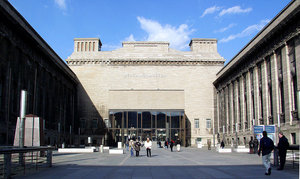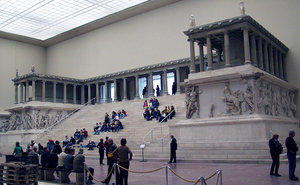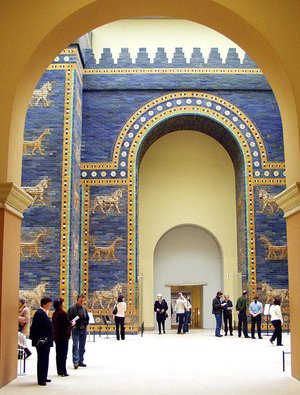Pergamon Museum
|
|
The Pergamon Museum (in German, Pergamonmuseum) is one of the museums on the Museum Island in Berlin. It was planned by Alfred Messel and Ludwig Hoffmann and was built over a period from 1910 to 1930. It houses original-sized, reconstructed monumental buildings such as the Pergamon Altar, the Market Gate of Miletus, and the Ishtar Gate, all consisting of parts transported from the original excavation sites.
The museum is subdivided into the antiquity collection, the Middle East museum and the museum of Islamic art. The museum is visited by approximately 850,000 people every year.
| Contents |
Origin
By the time the Kaiser-Wilhelm-Museum on Museum Island (today the Bodemuseum) had opened, it was clear that the museum was not large enough to host all the art and archeological treasures coming from German excavations. Excavations were done in Babylon, Uruk, Assur, Miletus, Priene and Egypt, and objects from these sites could not be properly displayed there. As early as 1907, Wilhelm von Bode, the director of the Kaiser-Wilhelm-Museum had plans to build a new museum nearby to accommodate ancient architecture, German post-antiquity art, and Middle Eastern and Islamic art.
This large three-wing museum had been planned since 1907; when Alfred Messel died in 1909 his close friend Ludwig Hoffman took charge of construction, which began in 1910. The construction continued during the First World War (1918) and the great inflation of the 1920s. In 1930 the building hosting the four museums opened.
The Pergamon Museum was severely damaged during the air attack on Berlin at the end of the Second World War. Many of the display objects were stored in safe places, and some of the large pieces were walled in for protection. In 1945, the Red Army collected all the loose museum items for a large Josef Stalin victory museum. Not until 1958 were most of the objects returned to East Germany. Some parts of the collection are still stored in the Pushkin Museum and the Hermitage in Moscow and St. Petersburg respectively. The return of these items has been arranged in a treaty between Germany and Russia, but is as of June 2004 blocked by museum directors in Russia.
Exhibition
Among the great pieces the museum displays are:
- The Pergamon Altar
- Market Gate of Miletus
- The Ishtar Gate and the Procession Street of Babylon
- The Mshatta Facade
The Antiquity Collection
The collection goes back to the Kurfürsten of Brandenburg, who collected objects from antiquity; the collection was started with an acquisition of the collection of an old Roman archeologist in 1698. It first became accessible (in part) to the public in 1830, when the Altes Museum was opened. The collection was expanded greatly with the excavations in Olympia, Samos, Pergamon, Miletus, Priene and Didyma.
This collection is divided between the Pergamon Museum and the Altes Museum.
The collection contains sculpture from archaic to hellenistic ages as well as artwork from Greek and Roman antiquity: architecture, sculptures, inscriptions, mosaics, bronzes and jewelry.
The main exhibitions are the Pergamon Altar from the 2nd century BC, with a 113 meters (371 feet) long sculptural frieze depicting the struggle of the gods and the giants, and the Gate of Miletus from Roman antiquity.
As Germany was divided, so was the collection following the Second World War. The Pergamon Museum was reopened in 1959 in East Berlin, while what remained in West Berlin is on display in the Castle of Charlottenburg since 1995.
Islamic Art Museum
When the Bode-Museum was opened in 1904, a section for Islamic art was created which was later on (in 1930) was included in the Pergamon Museum.
Besides artwork from the 8th to the 19th century by Islamic people from Spain to India, the main attraction is the Mshatta facade, which originates from a pre-Islamic desert castle. It was a gift from the Ottoman Sultan Abdul Hamid II to Emperor Wilhelm II of Germany. Parts of the facade are still in Amman, Jordan.
The Middle East Museum
The Middle East Museum exhibition displays objects, found by German archeologists and others, from the areas of Assyrian, Sumerian and Babylonian culture. Additionally there are historical buildings, reliefs and lesser cultural objects and jewelry.
The main display is the Ishtar Gate and the Procession Street of Babylon together with the throne room facade of Nebuchadrezzar II.
Future plans for the Museum Island
The main plan for the Museum Island dictates an expansion of the Pergamon Museum, which will become the centre of the museum complex. It will connect to Neues Museum, Bodemuseum and Alte Nationalgalerie and the new entrance building.
There was an architectural competition in 2000, won by Oswald Matthias Ungers from Cologne. The museum complex will be redeveloped according to his plan, which controversially propose large alterations to a set of buildings unchanged since 1930. The current entrance building will replace the building in Ehrenhof, and an elevated walk (Archäologische Promenade, archeologic walk) will connect the buildings. The rebuilding is scheduled to begin in 2005 and end in 2010.Template:Commons
da:Pergamonmuseet de:Pergamonmuseum hu:Pergamon Múzeum ja:ペルガモン博物館 no:Pergamonmuseum



